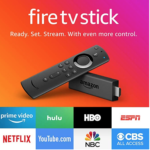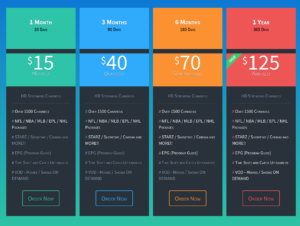Not long ago, I found myself staring at my satellite TV bill and wondering why I was paying $120 a month. With only a few exceptions, its hundreds of channels were a wasteland. I cut the cord. And I’ve never been happier. A lot of you have been asking me how I did it. So I created thIs guide to saying goodbye to satellite and cable. All of this won’t be for everybody. And it won’t replace a baseline service like Netflix or Hulu. But with a little effort, you can have more content than ever for a modest initial cost — and no additional monthly bills!
 1. Free TV ($43)
1. Free TV ($43)
Remember rabbit ears? Antennas aren’t shaped like that any more. But they still pick up scores of local channels. I found out how important that was when Hurricane Florence hit Wilmington. We didn’t have internet service and our satellite was out. Fortunately, I was able to get local channels using a generator and an antenna. In an emergency, that literally can be a life saver.
You can pick up a good antenna at Best Buy for thirty bucks. But keep this in mind: You’ll have to connect it to your TV through a co-axial cable. If the TV is on one side of a room and your window is on the other, that means having an unsightly cable running across the room.
Instead, I use Clear Stream. It’s an antenna with a wireless attachment that lets you pick up all the local channels wirelessly. Clear Stream’s Eclipse Sure Grip Indoor HDTV Antenna (35 Mile Range) retails for $39.99. But I was able to buy one on E-bay for $16. The company’s Over-the-Air Wi-Fi Tuner Adapter retails for $99. Ebay has a refurbished one for as low as $27.
Two other selling points: Clear Stream sends its wireless signal all over the house. So all you need is its app to see it on any TV. And it has limited DVR functionality. While you can’t set a timer to record programs, you can record them while they are playing live.
2. Amazon Fire Stick. ($39)
 It’s hard to overstate what a revolution this little three-inch device is. It’s like a computer that you plug into your TV through its HDMI port.
It’s hard to overstate what a revolution this little three-inch device is. It’s like a computer that you plug into your TV through its HDMI port.
The Fire Stick comes pre-loaded with content. And if you are an Amazon Prime member, you get tons more. (It has a ridiculously large library of old TV shows and movies, new offerings like Lore, and, increasingly, live sports.)
But, incredibly, that’s just the beginning.
3. Kodi. (Free)
The reason the Fire Stick is so versatile is that it works on an Android operating system. That means that, unlike Apple-TV, it lets you download things from outside developers. The downloading process can get a little wonkish. But it you’re willing to spend a few minutes watching a you-tube video, it’s easy to DYI.
It starts with downloading the Downloader app from the Fire Stick settings page. Once you do, a whole world opens up.
Think of your Fire Stick as a neighborhood. Kodi is the largest houses on the block. And since there’s no one living there (yet!), its closets are empty. You can fill up those closets with a nearly endless supply of channels. In Kodi-speak, these are called add-ons. The most popular add-on is called Exodus, and offers movies, TV shows and a whole lot more. But there are hundreds of specialty channels. One of my favorites is full of old black & white movies. Another allows me to watch out-of-market news broadcasts (so I can keep up with the disaster that it MSG.
The most popular add-on is called Exodus, and offers movies, TV shows and a whole lot more. But there are hundreds of specialty channels. One of my favorites is full of old black & white movies. Another allows me to watch out-of-market news broadcasts (so I can keep up with the disaster that it MSG.
These links will unlock Kodi: Download Kodi:. Download add-ons: See what add-ons are available:
One warning, though. As my friend Jacob Wolf points out on the Facebook version of this post, Kodi’s greatest advantage — its open source platform — is also its greatest disadvantage since it allows hackers to insert malware As he writes: “I’ve held off from using it for this reason and just stuck with Hulu + Live TV, with add-ons of Showtime and HBO. Far less than the traditional cable bill, for sure.” To educate yourself about Kodi malware, start here. It’s also a good idea to jump to (6) to learn about the protections offered by VPNs.
4. HB0 (Free… sort of)
I only watch a handful of shows on HBO. But I watch them religiously. Dish TV was charging me $15/month for HBO. But ever since AT&T took over Time Warner, it’s been giving HBO away. I was enticed to get my HBO in an AT&T bundle that cost $40/month. But I quickly dropped that for the same reason I dropped Dish TV: I wasn’t watching any of the channels.
The good news, which AT&T won’t always tell you, is that even if you don’t buy its bundles it will keep giving you free HBO. As long as you have AT&T as your wireless or internet service provider, you are entitled to HBO free for life.
5. IPTV Streams
A lot has been written about Internet Protocol TV services. They offer pirated content by setting up off-shore servers that collect TV signals and then re-stream the digital feeds to you via your Android TV box (aka Fire Stick.)It’s not hard to see why an estimated 26 million households in the U.S. and Canada use IPTV services that cost as little as $15/month.
If you’re a sports fan, it hurts paying for league packages that start at $120 a year. IPTVs include all NBA, NFL, and MLB in that low fee. Ditto Showtime, HBO, Cinemax. And pay-per-views, too. That’s in addition to the full roster of channels.
You may not want to take the leap into this world. But whether you choose to or not, it’s a good idea to use a little protection when you stream.
6. VPN (Est. $99 annually)
VPN stands for virtual personal network. But forget the details of what that means. All you need to know is that a VPN masks your IP address so no one knows where you are located when you access the internet.
If you have made the questionable decision to access pirated content, a VPN is essential.
But there are plenty of legitimate reasons to use a VPN, especially if you are concerned about someone snooping on your browsing history. The recent headlines regarding Facebook are certainly sobering. And as a reporter, I am always skittish about how some sites collect cookies.
After doing a bit of research, I bought an annual $99 subscription to Express VPN I’m using it on all of my TVs and computers, and am very happy.
You might not want to try all this — or even any if it feels overwhelming, But if you’re a little computer savvy and tired of those monthly TV bills, the savings add up.


